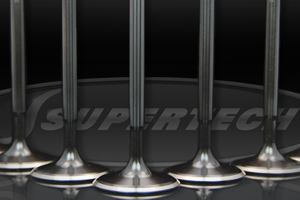


Supertech valve designs offer industry leading engineering, technology, and manufacturing. The result is superior flow rates, durability, stem finish, and dmensional tolerances. All valves are EV8 stainless steel with a hard nitride layer (black) for wear resistance, a superfinished stem to reduce friction, a hardened tip and valve seat surface for increased durability of these high stress areas, swirl polishing and undercut stems for improved flow rate and mixture quality. Exhaust valves for turbo applications are also available in an Inconel 751 high nickel alloy for improved durability at extreme temperatures. Inconel valves are without the nitride hardening and therefore are silver in color.
Usually ships in 2 to 3 days.
Can you explain the valve material options that are commonly used? Valve materials generally fall into one of three basic categories: stainless steel, high nickel super alloys, and titanium.
Titanium valves are used where mass and inertia need to be kept to an absolute minimum such as large valve normally aspirated applications running to very high rpm. The disadvantages of titanium, aside from the very high cost, include a tendency to gall and wear excessively anywhere there is contact. They generally require the use of special coatings and careful consideration of the valve guide and seat materials used to minimize these issues. Additionally, an optimization of the valve margin widths and seat angles may be required to achieve the best possible results depending on the application.
High nickel super alloys such as Inconel 751 and Nimonic 80 are usually selected as an exhaust valve material in demanding turbocharger applications where sustained high exhaust temperatures are anticipated. These alloys retain excellent tensile strength to very high temperatures and will greatly extend the life and reliability of the exhaust valve under these conditions when compared to typical stainless steel valve materials.
21-4N (EV8) stainless steel alloy is probably the most common high performance valve material on the market and offers an excellent balance between performance and cost. This material is offers sufficient tensile strength at elevated temperatures that it can be used for exhaust valves in turbocharged applications although Inconel will be a better choice when budgets allow.
What design features are used to improve flow into the combustion chamber? An undercut valve stem which means that the diameter of the stem is reduced where the stem passes through the intake port. Additionally, special selection of surface finishing techniques, valve head design, and valve angles maximizes the flow potential past the valve.
Should I machine the valve seats when installing new valves? It is always a good idea to machine the valve seats if there is any question as to their condition so that there is good contact between the valve and the seat. Valve cooling is highly dependent on sufficient contact area between the valve head and the valve seat and poor valve seat condition can cause the valve to operate at elevated temperatures. Obviously if you are installing a larger valve diameter the valve seats will need to be machined to the proper dimensions.
What about valve clearances? It is likely that the valve clearances will change when installing new valves and/or cutting the valve seats. The valve clearances should always be set during the installation. Valve clearances are required with a solid lifter to accomodate for thermal expansion as well as valve and seat wear over time. A valve clearance that is too tight can potentially allow the valve to remain slightly open all the time which will cause the valve to overheat as well as create a loss in compression. A valve clearance that is too loose will cause a reduction in valve lift and timing resulting in a loss of performance. It can also create excessive valvetrain noise and damage due to the valve hitting the seat while it is still moving at high velocity.
What else do I need to consider when installing new valves? The valve seals should always be replaced. Additionally, each valve guide's size and condition needs to be checked. Excessive wear or uneven wear along the length of the guide would require its replacement. The clearance between the valve and the guide must be correct and it may be necessary to hone new or used guides to the proper size. Surface finish of the guide is also important and for this reason diamond honing of the guide is the preferred method.
What is a sodium filled valve and what is the advantage? Sodium is a metal that is liquid when the valve is at operating temperature. A sodium filled valve uses a hollow stem that is partially filled with sodium. At operating temperatures the movement of the liquid metal helps to transfer heat from the head of the valve to the stem and thus into the valve guide improving the cooling of the valve.